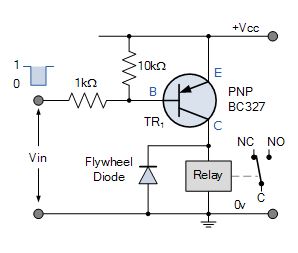Table of Contents
Relays control circuits by opening and closing contacts in another circuit. It take a relatively small amount of power to operate the coil, but this itself can be used to control motors, heaters, lamps or AC circuits which themselves can draw a lot more electrical power.
These switches are used to open and close circuits electromechanically or electronically. When the contact is open, it is not energized. When it is closed, there is a closed contact when it is not energized. In either case, applying an electrical current to the contacts will change their state.
They are generally used to switch smaller currents in a control circuit and do not usually control power consuming devices except for small motors and Solenoids that draw low amps. Nonetheless, It can “control” larger voltages and amperes by having an amplifying effect because a small voltage applied to a coil can result in a large voltage being switched by the contacts.
Pin Diagram


Protective relays can prevent equipment damage by detecting electrical abnormalities, including overcurrent, undercurrent, overloads and reverse currents. In addition, these are also widely used to switch starting coils, heating elements, pilot lights and audible alarms.
Types:
In electromechanical relays (EMR), contacts are opened or closed using magnets. Solid-state relays (SSR) have no contacts and switching is totally electronic. Functions performed by heavy-duty equipment often need switching capabilities of electromechanical relays. SSR switch current using non-moving electronic devices such as silicon controlled rectifiers.
SSR do not have to energize a coil or open contacts. They require lesser voltage for switching and turn on and off faster because there are no physical parts to move.
Although the absence of contacts and moving parts means that SSR are not subject to arcing and do not wear out. Contacts on electromechanical relays can be replaced, whereas entire SSR must be replaced when any part becomes defective. Because of the construction of SSR, there is residual electrical resistance and/or current leakage whether switches are open and closed.
There are many types of relay switches available, but many times transistors and MOSFETs are used as the main switching device. Transistors provide fast switching control of the coil from various sources.
A typical relay switch circuit has the coil driven by a NPN transistor switch, TR1 as shown depending on the input voltage level. When the Base voltage of the transistor is zero (or negative), the transistor is cut-off and acts as an open switch. In this condition, no Collector current flows and is de-energised because being current devices, if no current flows into the Base, then no current will flow through the coil.
Relay Switch Circuits
NPN Relay Switch Circuit
When the Base voltage of the transistor is zero (or negative), the transistor is cut-off and acts as an open switch. In this condition, no Collector current flows and is de-energised because being current devices, if no current flows into the Base, then no current will flow through the coil.

NPN Darlington Relay Switch Circuit
The two NPN transistors are connected so that the Collector current of the first transistor, TR1 becomes the Base current of the second transistor TR2. The application of a positive base current to TR1 automatically turns “ON” the switching transistor, TR2.

Emitter Follower Relay Switch Circuit
Common Collector or Emitter follower configuration is very useful for impedance matching applications because of the very high input impedance (~hundreds of thousands of Ohms) while having a relatively low output impedance to switch the coil.

Emitter Darlington Relay Switch Circuit
A very small positive Base current applied to TR1 causes a much greater Collector current to flow through TR2 due to the multiplication of the two Beta values.

PNP Relay Switch Circuit
This circuit requires different polarities of operating voltages. Load current flows from the Emitter to the Collector when the Base is forward biased with a voltage that is more negative than that at the Emitter. For the relays load current to flow through the Emitter to the Collector, both the Base and the Collector must be negative in respect to the Emitter.

PNP Collector Relay Switch Circuit
The relay load is connected to the PNP transistors Collector. The ON-OFF switching action of the transistor and coil occurs when Vin is LOW, transistor “ON” and when Vin is HIGH, transistor “OFF”.

N-channel MOSFET Relay Switch Circuit
The MOSFET relay switch circuit is connected in common-source configuration. With zero voltage input, LOW condition, the value of VGS, there is insufficient Gate drive to open the channel and the transistor is “OFF”.

P-channel MOSFET Relay Switch Circuit
When a HIGH voltage level is applied to the Gate, the P-channel MOSFET will be turned “OFF”. The turned “OFF” E-MOSFET has a very high channel resistance and acts nearly like an open circuit. When a LOW voltage level is applied to the Gate, the P-channel MOSFET will be turned “ON”.

Logic Controlled Relay Switch Circuit
A relatively small positive voltage greater than the threshold voltage VT, on its high impedance Gate causes it to begin conducting current from its Drain terminal to its Source terminal. Unlike the bipolar junction transistor which requires a Base current to turn it “ON”, the e-MOSFET only requires a voltage on the Gate as due to its insulated Gate construction, zero current flows into the gate.

BJT’s make for good and cheap relay switching circuits, but they are current operated devices. They convert a small Base current into a larger load current to energize the coil. However, the MOSFET switch works better as an electrical switch as it takes virtually no Gate current to turn it “ON”, converting a Gate voltage into a load current. Therefore, a MOSFET can be operated as a voltage-controlled switch.

More basic articles available in the learning corner.
This article was first published on 5 June 2017 and was updated on 29 October 2024.














